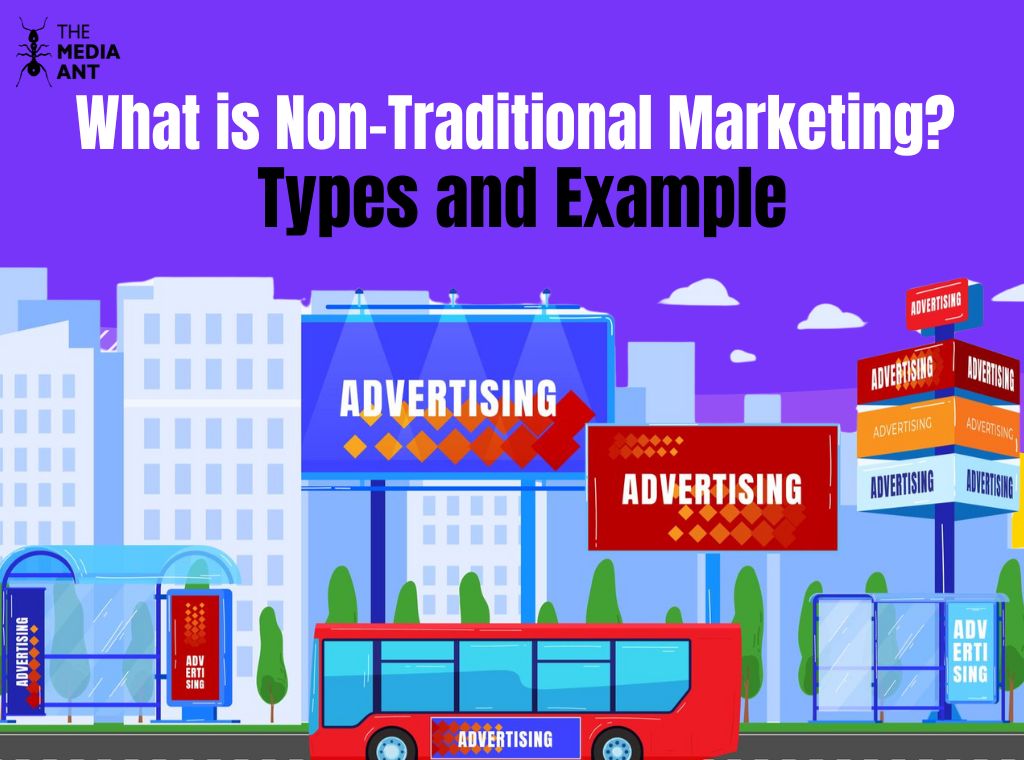Understanding Non-Traditional Marketing
Non-traditional marketing is all about using creative and unconventional ways to promote products or services. Unlike traditional marketing, which relies on TV ads, newspapers, and billboards, non-traditional marketing uses new and innovative techniques to capture people’s attention.
Key Features of Non-Traditional Marketing
- Creativity: It involves thinking outside the box and coming up with unique ideas that stand out.
- Engagement: It focuses on creating a memorable experience for the audience, making them more likely to remember the brand.
- Cost-Effectiveness: Many non-traditional marketing methods can be cheaper than traditional ones, making them ideal for small businesses.
- Digital Focus: With the rise of the internet and social media, non-traditional marketing often uses online platforms to reach a wider audience.

Types of Non-Traditional Marketing
Guerrilla Marketing
Guerrilla marketing is all about surprise and creativity. It involves using unconventional tactics to catch people’s attention in public places. Think of flash mobs, street art, or eye-catching installations. The goal is to create a buzz and get people talking about your brand. It’s a cost-effective strategy that relies on creativity rather than big budgets, making a significant impact with minimal investment.
Experiential Marketing
Experiential marketing focuses on creating memorable experiences for consumers. Instead of just telling people about a product, it invites them to engage with it directly. This could be through pop-up shops, interactive events, or immersive installations. The idea is to build an emotional connection with the audience, making them more likely to remember and talk about the brand. It’s all about making the consumer an active participant in the brand story.
Viral Marketing
Viral marketing aims to create content that spreads rapidly online, much like a virus. This is typically done through entertaining, shocking, or highly relatable content that people feel compelled to share. Social media platforms play a crucial role in viral marketing, as they provide the perfect environment for content to be shared and reach a wide audience quickly. Successful viral campaigns can significantly boost brand awareness and engagement.
Content Marketing
Content marketing involves creating and sharing valuable content to attract and retain customers. This can include blog posts, videos, infographics, podcasts, and more. The focus is on providing useful information that addresses the needs and interests of your target audience. By consistently delivering quality content, you build trust and credibility with your audience, which can lead to increased loyalty and sales over time.
Affiliate Marketing
Affiliate marketing is a performance-based strategy where businesses reward affiliates for driving traffic or sales to their website. Affiliates, often bloggers or social media influencers, promote the business’s products or services to their audience and earn a commission for each sale made through their referral links. This approach allows businesses to reach new audiences and boost sales without upfront marketing costs, while affiliates benefit from earning passive income.
Real-World Example of Non-Traditional Marketing
ALS Ice Bucket Challenge
The ALS Ice Bucket Challenge in 2014 became a textbook example of viral marketing. Participants filmed themselves pouring ice water over their heads, nominated others to do the same, and donated to ALS research. The simplicity and fun of the challenge, combined with its charitable cause, made it an internet sensation. Celebrities and public figures joined in, amplifying its reach. The campaign raised over $115 million for ALS research and significantly increased awareness of the disease.
Future of Non-Traditional Marketing
- Advanced Technology Integration: AI and machine learning will revolutionize personalized marketing campaigns, while VR and AR will become mainstream, offering immersive brand experiences.
- Focus on Authenticity: Consumers will increasingly seek genuine, transparent interactions, pushing brands to emphasize authenticity. User-generated content and influencer partnerships will grow, prioritizing relatability and trustworthiness.
- Sustainability and Ethical Marketing: Eco-friendly practices and ethical marketing will gain prominence as consumer awareness of environmental and social issues continues to rise, influencing brand loyalty and purchasing decisions.
- Rise of Micro-Influencers: Micro-influencers with smaller, highly engaged followings will become more valuable for brands, fostering stronger connections and trust within niche markets.
- Omni-Channel Marketing: Seamless integration across multiple platforms will be crucial, ensuring a consistent brand experience. Advanced data analytics will enable more cohesive and personalized marketing efforts.
- Experiential and Event Marketing: As the world recovers from the pandemic, in-person and hybrid events will thrive, creating memorable experiences that foster deeper emotional connections with audiences.
- Content Diversification: Video content, particularly short-form videos on platforms like TikTok and Instagram Reels, will dominate. Podcasts and audio content will also continue to grow, offering engaging ways to reach consumers.
- Data Privacy and Consumer Consent: With growing concerns over data privacy, transparency in data collection and usage will be essential. Brands that build trust through ethical data practices will gain a competitive edge.
- Local and Hyper-Local Marketing: There will be a greater focus on targeting specific communities with tailored messages, using sophisticated geo-targeting and local SEO techniques.
- Evolving Social Media Landscape: Brands will need to stay agile and adapt quickly to new social media platforms and features. The expansion of social commerce will make it easier for consumers to make purchases directly from their feeds.

FAQs Related To Non-Traditional Marketing
What is a nontraditional form of advertising?
A nontraditional form of advertising uses innovative and unconventional methods to capture the audience’s attention. Unlike traditional ads seen on TV, radio, or print, nontraditional advertising often leverages digital platforms, guerrilla tactics, or immersive experiences to create a memorable impact.
What are nontraditional examples?
Guerrilla Marketing: Flash mobs or street art installations that surprise and engage the public.
Experiential Marketing: Interactive pop-up events where consumers can experience a brand firsthand.
Viral Marketing: Online content designed to be widely shared, such as funny videos or trending challenges.
Influencer Marketing: Collaborating with social media influencers to promote products authentically.
Content Marketing: Creating valuable content, like blogs or videos, that educates or entertains the audience.
What is the difference between traditional and non traditional advertising?
Traditional advertising relies on established media channels such as TV, radio, newspapers, and magazines to deliver a brand’s message to a broad audience. Nontraditional advertising, on the other hand, uses creative and often digital methods to engage consumers in more personal and interactive ways. Traditional ads are usually one-way communications, while nontraditional methods foster two-way interactions and experiences.
What is the non paid form of advertisement?
Non-paid advertising, also known as earned media, includes organic publicity gained through word-of-mouth, social media shares, customer reviews, and press coverage. Unlike paid ads, earned media is gained through the inherent value of the content or product, leading to genuine and often more trusted endorsements.





